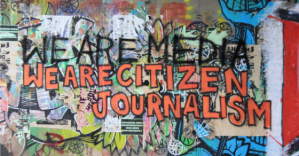
Imagine, waking up in the morning, making your breakfast and coffee as usual and setting off out of the house like any other day. Moments into your journey you have been stopped by a crowd of people standing, watching and waiting as the event unfolds; you have just released you have become an eye witness to an extraordinary event. No news crew insight, so you decide to take out your phone and start to capturing and posting the footage and photos online. You have just become a Citizen Journalist.
Over the past decade, Citizen Journalists or eyewitnesses have emerged and have played a vital role in capturing, documenting and sharing extraordinary events through the use of various social media platforms. The most famous example of Citizen Journalism came about on November 22 1963, when Abraham Zapruder captured the assassination of President Kennedy. Three copies of the film were made, two were handed to the authority and one was sold for $150,000.Crazy enough, the aftermath of some of the world most extraordinary disasters have been captured by Citizen Journalists.
The start of Citizen Journalism: the 9/11 Attacks on New York City
The 9/11 attacks on New York City were the start of the citizen journalism, as back in 2001 this type of journalism didn’t really exist due to the lack of camera phones and social media platforms. The horrific events of 9/11, saw a media frenzy of Citizen Journalism emerge in traditional media methods as ordinary people were capturing and reporting the attacks that journalists couldn’t. The demand for news updates and information during this attack were enormous, however people were only able to access these updates through television and radio. September 11 changed the Internet in regards to the way we search and need information on demand (Johnson 2011).
The Hudson River Plane Crash

The social media platform Twitter played a role in breaking the news to the world of the Hudson River Plane Crash. Unlike the 9/11 attacks, the event sent the social media world in the ciaos. Twitter users broke the news of the incident around 15 minutes before the mainstream media alerted viewers and readers of the crash (Beaumont 2009), showing the impact of Citizen Journalism during this event. On this day, ordinary people were the media.
The Race Against Time
Journalist race against the clock to provide information to the public as quickly as possible. Social media enables citizens to share information with each other and with emergency officials; contributing to the different stages of crisis management (Watson & Wadwha 2013). On-the-Ground News (ONGR), is a revolutionary social media news source that encourages the participant of ordinary people to contribute news stories from all over the world; enabling citizens to become the media.
Citizen Journalists have already made a large impact on society over the past decade and are playing an influential role in providing quick news updates on extraordinary events. The comparison between the coverage of the 9/11 attacks and the Hudson River Plane Crash, identifies the growth and importance of citizen journalism within todays modern society.
Do you agree with the notion that Citizen Journalists are the media?
Reference List:
Barnes. C. Citizen Journalism vs. Traditional Journalism: A case for collaboration. Academic journal article. Caribbean Quarterly. Viewed 13th of August 2015. https://www.questia.com/library/journal/1P3-2839151391/citizen-journalism-vs-traditional-journalism-a-case
Beaumont, C, 2009, New York plane crash: Twitter breaks the news again, The Telegraph, 16 January, viewed on 27 August 2015, http://www.telegraph.co.uk/technology/twitter/4269765/New-York-plane-crash-Twitter-breaks-the-news-again.html
Bowman, S & Willis, C 2003, We Media: How Audiences Are Shaping the Future of News and Information, American Press Institute.
DeMers, J, 2013, How Social Media is Supporting a fundamental Shift in Journalism, The Huffington Australia, 9 May, viewed 28 August 2015, http://www.huffingtonpost.com/jayson-demers/how-social-media-is-suppo_b_3239076.html?ir=Australia
Elliot, J 2013, Citizen Journalism- 9/11 Case Study, Journalism and The Online Revolution, Posted 11 January, WordPress, viewed 1 September 2015, https://jameselliott92.wordpress.com/2013/01/11/citizen-journalism-911-case-study/
Gilmor, D 2004, We the Media: Grassroots Journalism By the People For the People O’Reilly Media, Sebastapol, CA
Henriquez, G, 2012, The Rise and Impact of Citizen Journalism, Posted 19 October 2012, BlogSpot, Viewed 27 August, http://hightechgalore.blogspot.com.au/2012/10/the-rise-and-impact-of-citizen.html
Johnson, J, 2011, How the Internet Changed after 9/11- Citizen Journalism, Social Media and Mobility, Media Rhetoric.com, 11 September, viewed 29 August 2015, http://www.mediarhetoric.com/blog/how-the-internet-changed-after-911-citizen-journalism-social-media-and-mobility
Watson, H & Wadhwa, K 2013, The Evolution of Citizen Journalism in Emergency Management, Emergency Management, Training & Education, 25 October, viewed on 28 of August 2015, http://www.emergencymgmt.com/training/Citizen-Journalism-Emergency-Management.html
